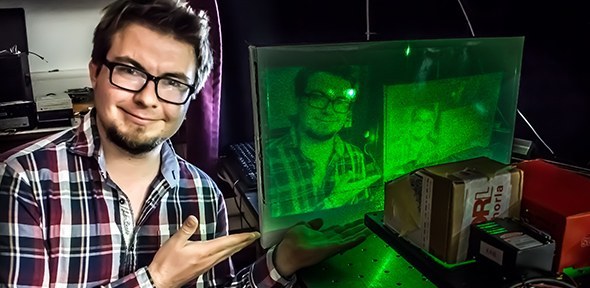
Spotlight on industry partner: VividQ and computer-generated holography
Holographic displays project realistic 3D digital content that floats in front of your eyes. It is a visual experience that is transforming the way we view, interact and connect with the world around us, says Photonics CDT alumnus and industry partner, Andrzej Kaczorowski.
VividQ, the start-up Andrzej co-founded following his PhD, is delivering these types of realistic and immersive visual experiences to next-generation digital displays.
Here Andrzej reveals more about the VividQ story.
From a young age I was fascinated by the inner workings of the devices and objects around me and would often take household appliances to bits. I began computer programming at the age of 13 and spent hours in the high school lab. These passions motivated my choice of degree - a BSc in Physics with Computer Science at King’s College London followed by Master of Research (MRes) and a PhD in Photonic Systems Development from the University of Cambridge. My PhD laid the groundwork on which VividQ was founded.
My PhD research explored the ways in which computer-generated holography can be improved and implemented in realistic devices such as pico projectors, optical lithography devices and mixed reality headsets. This included improving the quality of the image, speeding up the computation of holograms and correcting optical imperfections in the software.
During this time, I demonstrated the first real-time high-quality holographic projections on off-the-shelf Graphics Processing Units (GPUs), while under the supervision of Professor Tim Wilkinson. The method I developed in my research offered hologram generation of up to three orders of magnitude faster than the standard method.

IMAGE: Andrzej is pictured in 2014 with the holographic projector he built during his PhD at Cambridge. © Andrzej Kaczorowski.
Towards the end of my degree, I met my co-founders, Dr Darran Milne and Tom Durrant. We were joined by Dr Roman Pechhacker, Aleksandra Pedraszewska and my PhD colleague, Dr SJ Senanayake, to form VividQ in 2017.
VividQ is a deep-tech software start-up that is on the path to revolutionising display technology. Our software enables the integration of holographic displays into Augmented Reality (AR) smart glasses, Head-Mounted Displays (HMDs), Head-Up Displays (HUDs) and consumer electronics.
This year, VividQ has a line-up of exciting advancements, including:
- 'HoloLCD' – a laptop scale holographic display that uses regular LCD (Liquid Crystal Display) panels to give a complete 3D experience, without the need for glasses.
- 'VividQ Alpha' – holographic AR smart glasses providing immersive content with a large field of view in an ergonomic and consumer-friendly package.
- Continued development of our prototyping activities in holographic HUDs.
Innovation has always been at the core of what we do. The dedicated research team at VividQ is focusing on the next-generations of holographic displays - looking five to 10 years ahead. The topics we explore range from nanophotonics and material science, through hologram computing methods, realism in computer-generated imagery and media production workflows.
I am a technologist and inventor at heart. Bringing inventions to life is a deeply rewarding experience. I love the whole process, from brainstorming and coming up with an idea to creating the first working prototype that demonstrates functionality not achieved before.
I coordinate joint research projects with the University of Cambridge and University College London (UCL) via the Centre for Doctoral Training in Connected Electronic and Photonic Systems, among others. Seeing people grow and develop gives me a lot of satisfaction and it has been a joy to share my knowledge and expertise in this way.
Read more
Published: 07 Feb 2022
Full article: http://www.eng.cam.ac.uk/news/alumni-stories-welcome-andrzej-s-world-computer-generated-holography
Dr Andrzej Kaczorowski – technologist, researcher, inventor. PhD in Photonic Systems Development.
Credits: VividQ, Department of Engineering, University of Cambridge.
Images: © Andrzej Kaczorowski.
